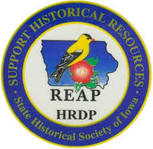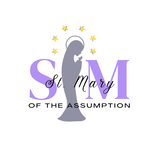Learn more About Us
Settled by German immigrants, West Point's first Catholic church was established by Father John Alleman in 1842 as a mission church or nearby Fort Madison, Iowa. When he decided to start the church, he spent a week collecting money for the building. After a week, Fr. Alleman had collected a sum of eighty-five cents. In 1842 the first frame structure church was built just south of the present church. The first church bell, from Sugar Creek Church, was donated by Bishop Mathias Loras to the West Point Catholic Church, then called St Phillip's. No longer in use, this bell is still intact and is displayed in the tower of the Marquette Junior High.
The first resident pastor, Father B. Wolterman, was appointed in June 1855 and remained until February 1856. He opened the first baptismal register now existing in St. Mary's Church.
Father J. G. Reffe succeeded Fr. Wolterman and initially held services in the frame church. In 1858 construction of the present church began under his direction. Bricks from the building were made in a kiln, which was located on a spot in the present cemetery. Members of the parish provided most of the labor. The cost of the building is not known, but the cash outlay was about $6,000. Three fine-toned bells cost about $3,000.
Father M. Michels arrived in 1864 followed by Father A. Hattenburger in 1867. It was during his stay that the rectory was built.
The next two pastors of St. Mary's Parish were Father Clement Johannes and Father J. Orth, staying until 1877 when Father William Jacoby was assigned pastor. Fr. Jacoby's first improvements were to replace the brick floor of the church with pine lumber and to replaster the walls and ceiling. His next improvement was to add to the west end of the church. A new high altar and side altars were carved. In 1874 a chapel was built on the cemetery.
On his way to Europe in the late 1800s, Fr. Jacoby stopped at the world's Columbian Exposition in Chicago. It was there that a statue of the Assumption of Mary by Frank Bobert and Sons of Paris, France was on exhibition. Rather than send the statue back to France the company sold it at a reduced price to Fr. Jacoby and Henry Boeding. Fr. Jacoby had it placed in the high altar of St. Mary's Church. This work of art continues to inspire the parish's devotion to Mary, the mother of Jesus.
Also under the direction of Fr. Jacoby, St. Aloysius hall was built in 1895. In 1903 Fr. Jacoby remodeled the church by adding a dome. He retired in 1915 because of ill health. Father Grothe assumed the responsibility of the parish. He died in 1933. The next pastor was Father Scherf who built the addition to St. Mary's Rectory in 1936..
Father J. A. Wagner succeeded Fr. Scherf as pastor in 1939. In 1941 two confessionals were added to the rear of the church, one of which is still used. In 1942, before the celebration of its one hundredth anniversary, the entire church was renovated. In August 1956 Fr. Wagner was invested with the title of Monsignor. That was the first time a pastor of St. Mary's was bestowed this honor.
Father Francis Lenoch was the next pastor, assuming his responsibilities in the 1970. During his stay the interior of the church was redecorated. Ten years later, in the 1980, Father Thomas Doyle replaced Fr. Lenoch. In 1983 Father Gerald Stouvenal took over the parish. It was at this time that the Ossenbrink Memorial Center was added to the church. It was dedicated in 1985.
Father David Wilkening was assigned pastor in 1991. He served the parish until 2002. Under his direction the church was again redecorated to reflect the style of the church as it appeared in the 1940's and 1950's. Father Apo Mpanda replaced Fr. Wilkening in 2002 and was tranferred to Davenport in June 2010. Father Dennis Hoffman came in July of 2010 and served until 2022. In July of 2022 St. Mary's became a part of the 4 parish cluster of St. Mary's, St. Boniface, St. James and St. John with Father Dan Dorau as Pastor.
Settled by German immigrants, West Point's first Catholic church was established by Father John Alleman in 1842 as a mission church or nearby Fort Madison, Iowa. When he decided to start the church, he spent a week collecting money for the building. After a week, Fr. Alleman had collected a sum of eighty-five cents. In 1842 the first frame structure church was built just south of the present church. The first church bell, from Sugar Creek Church, was donated by Bishop Mathias Loras to the West Point Catholic Church, then called St Phillip's. No longer in use, this bell is still intact and is displayed in the tower of the Marquette Junior High.
The first resident pastor, Father B. Wolterman, was appointed in June 1855 and remained until February 1856. He opened the first baptismal register now existing in St. Mary's Church.
Father J. G. Reffe succeeded Fr. Wolterman and initially held services in the frame church. In 1858 construction of the present church began under his direction. Bricks from the building were made in a kiln, which was located on a spot in the present cemetery. Members of the parish provided most of the labor. The cost of the building is not known, but the cash outlay was about $6,000. Three fine-toned bells cost about $3,000.
Father M. Michels arrived in 1864 followed by Father A. Hattenburger in 1867. It was during his stay that the rectory was built.
The next two pastors of St. Mary's Parish were Father Clement Johannes and Father J. Orth, staying until 1877 when Father William Jacoby was assigned pastor. Fr. Jacoby's first improvements were to replace the brick floor of the church with pine lumber and to replaster the walls and ceiling. His next improvement was to add to the west end of the church. A new high altar and side altars were carved. In 1874 a chapel was built on the cemetery.
On his way to Europe in the late 1800s, Fr. Jacoby stopped at the world's Columbian Exposition in Chicago. It was there that a statue of the Assumption of Mary by Frank Bobert and Sons of Paris, France was on exhibition. Rather than send the statue back to France the company sold it at a reduced price to Fr. Jacoby and Henry Boeding. Fr. Jacoby had it placed in the high altar of St. Mary's Church. This work of art continues to inspire the parish's devotion to Mary, the mother of Jesus.
Also under the direction of Fr. Jacoby, St. Aloysius hall was built in 1895. In 1903 Fr. Jacoby remodeled the church by adding a dome. He retired in 1915 because of ill health. Father Grothe assumed the responsibility of the parish. He died in 1933. The next pastor was Father Scherf who built the addition to St. Mary's Rectory in 1936..
Father J. A. Wagner succeeded Fr. Scherf as pastor in 1939. In 1941 two confessionals were added to the rear of the church, one of which is still used. In 1942, before the celebration of its one hundredth anniversary, the entire church was renovated. In August 1956 Fr. Wagner was invested with the title of Monsignor. That was the first time a pastor of St. Mary's was bestowed this honor.
Father Francis Lenoch was the next pastor, assuming his responsibilities in the 1970. During his stay the interior of the church was redecorated. Ten years later, in the 1980, Father Thomas Doyle replaced Fr. Lenoch. In 1983 Father Gerald Stouvenal took over the parish. It was at this time that the Ossenbrink Memorial Center was added to the church. It was dedicated in 1985.
Father David Wilkening was assigned pastor in 1991. He served the parish until 2002. Under his direction the church was again redecorated to reflect the style of the church as it appeared in the 1940's and 1950's. Father Apo Mpanda replaced Fr. Wilkening in 2002 and was tranferred to Davenport in June 2010. Father Dennis Hoffman came in July of 2010 and served until 2022. In July of 2022 St. Mary's became a part of the 4 parish cluster of St. Mary's, St. Boniface, St. James and St. John with Father Dan Dorau as Pastor.

St. Mary's has completed a restoration of the Blessed Mary of the Assumption painting created by Melchior Paul von Deschwanden in 1868.
This project was supported in part by the State Historical Society of Iowa,
Historical Resource Development Program. The remainder of the funding was provided by special donations of our generous parish members.
If you would like to learn more about this painting, the artist and its history in our parish please see our brochure.
The painting remains in the front of the church for you viewing daily until 7pm.
For more information you may go to our Picture restoration page.
This project was supported in part by the State Historical Society of Iowa,
Historical Resource Development Program. The remainder of the funding was provided by special donations of our generous parish members.
If you would like to learn more about this painting, the artist and its history in our parish please see our brochure.
The painting remains in the front of the church for you viewing daily until 7pm.
For more information you may go to our Picture restoration page.

